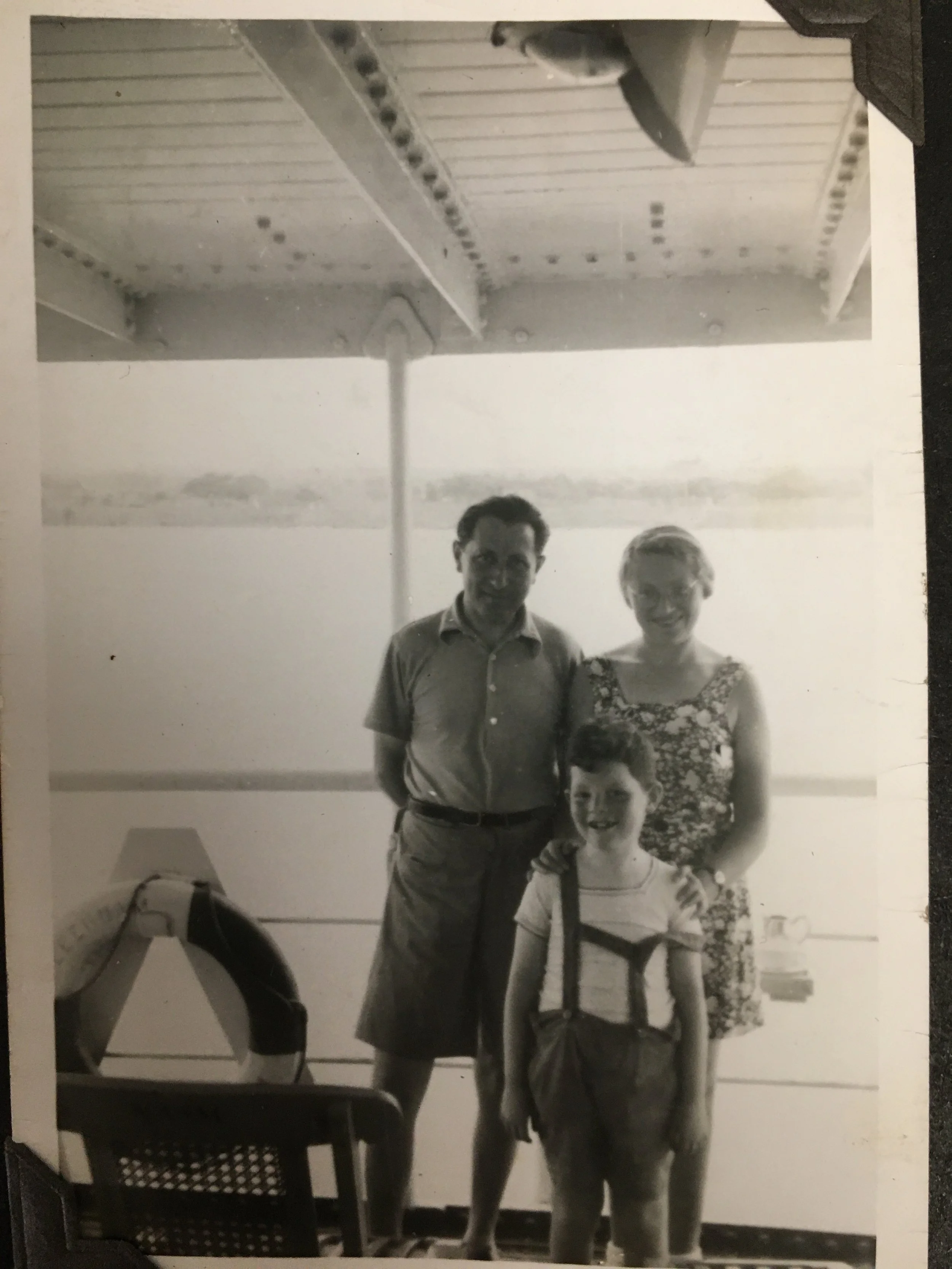By: Miriam Glaser Lipsky
It all started with a box.
A box that was found at the back of a storage space under the stairs at the time my parents were selling their house to move to a retirement community. A box that was like a time capsule… with photos from the 1920’s and 1930’s of my family in Vienna… with passports stamped with a red “J,” with a frantic letter from my great-grandparents who were living in Antwerp and asking for help in getting out of Europe.
Around the time I joined 3G Miami, I found this box. Around that same time, a distant cousin from Canada (the granddaughter of my grandfather’s brother), reached out to connect with me and my sister and share family history information.
And so began my deep, deep dive into my family’s Holocaust-era history.
In Yiddish there’s a word, beshert, for something that was meant to be. And so, it was beshert that I signed up for the 3G Philly book club reading of Born Survivors by Wendy Holden. I read a lot of historical fiction related to the Holocaust and WWII, so this book was of particular interest to me. I naturally assumed that it would be of similar interest to other 3Gs, and that the book club Zoom meeting would have so many people that I wouldn’t even bother turning my camera on - in fact, it had been a long and busy day and I almost decided not to join the book club that night. That would have been a huge mistake!
It ended up that the book club only had about 10 participants from various 3G groups around the country, and at one point the discussion leaders asked if anyone had returned to see where their family had lived in Europe (this was relevant to the book). I mentioned that my sister and I had an upcoming trip to Belgium and the Netherlands, and we had planned to stop in Antwerp because we had the address where our great-grandparents had lived and, we thought, been hidden during the war. (As with many 2G/3G’s, my family rarely spoke of this time in our history, and my sister and I were always told not to ask our grandparents about this time in their lives because it was too painful for them to discuss, so we didn’t have much information to go on. In fact, we had only found out about this address of our great-grandparents through the distant cousin with whom we had recently become acquainted.)
Our family had lived in Vienna in the 1930’s and in 1938 fled from there to Antwerp after the Nazi invasion. When I shared about my upcoming visit to Antwerp, one of the other book club participants, Levi Greenspan, asked if I could share the address because his family had also lived in Antwerp, and when I shared the address Levi thought this was in the Jewish section of Antwerp. He explained that he had been to Antwerp to do research on his family and that there was a Holocaust museum/memorial near Antwerp - Kazerne Dossin - where he had been able to connect with an archivist to do research on his family. The name Kazerne Dossin (or Caserne Dossin) sounded familiar to me and I kept wondering where I had heard it before, and then I realized that it was in the post-war documents that I had discovered as we packed up my parent’s house when they moved - a document from “the box.” It was a document that had been sent to my paternal grandmother and explained the fate of her mother - Frieda Sperber Kohn. The document said that Frieda had been sent to Auschwitz (via Caserne Dossin). She was an older woman (in her late 50’s at the time) and was presumed murdered upon arrival.
Levi was so generous in sharing the information that he had about Caserne Dossin (translated = the Dossin Barracks), and I contacted the archivist he had worked with, Dorian Styven. I read on the museum’s web site that they had a wall of remembrance with photos of all of the people who had passed through Caserne Dossin, so when I contacted Dorian, I offered to send a photo of my great grandmother to include on the wall (I had exactly two photos of her - from the box - and felt very lucky to have them). I was shocked when Dorian replied that there was no need to send a photo - they already had one (!) - and she sent me a copy. It was a photo from Frieda’s immigration paperwork. I was intrigued! What other information was out there about my family? I promptly made an appointment to meet with Dorian when my sister and I were in Belgium.
The Kazerne Dossin Memorial, Museum, and Research Centre on Holocaust and Human Rights is in a town called Mechelen (in Belgium). It lies between Brussels and Antwerp. My sister and I stopped there enroute from Brussels to Antwerp, so we had all of our luggage with us. Little did we know that the train station is tiny, and there were no cabs or Ubers to be had (we tried!), and so we rolled our heavy suitcases for about a mile over cobblestone streets and bridges to get to the museum, but we made it! We then spent almost three hours with Archivist Dorian Styven going through all of the files that were in the archive about our family. Dorian was so generous with her time, and we will forever be grateful that the Kazerne Dossin museum provides this service to the families of Holocaust victims.
We learned that Frieda’s husband, our great grandfather Abraham Kohn, had been arrested and sent to several camps in France while his wife Frieda was still living in Antwerp. (He eventually escaped and was able to join my father and grandparents in Mexico, where they had fled after their stay in Antwerp). We had always wondered how Frieda and Abraham became separated, and now we knew. From the various documents, we were able to find out the three addresses where Frieda and Abraham (and then Frieda alone) lived in Antwerp. We learned that it was possible that our other set of great-grandparents could have managed to live in their house (at the address I had shared with Levi) throughout the war. The story we had heard was that they had been hidden, but the documents that were shared with us at the archive, as well as documents we had from our cousin, suggested that they had lived in their house in Antwerp throughout the war, and Dorian said that this might have been possible if they just didn’t go out - at least during the day. She said she knew of cases like this.
We learned that our great-great uncle, Isak Kiewitz, had also passed through Caserne Dossin before being sent to Auschwitz, where he was murdered. He was apparently in one of the last groups that was rounded up, and so unlike most earlier people who passed through Caserne Dossin (whose papers were burned upon arrival), his paperwork had not been destroyed. In his papers, there was a letter from his son Karl, my father’s cousin, who had been sent to a work camp, asking his father to send him more clothes. Karl was later murdered at Auschwitz as well. In our extended family, no one had a photo of Karl, but at least now we had a letter in his own handwriting! Dorian offered to do more research to see if she could find a photo of Karl, and miraculously, through the help of her colleagues, they found a photo of Karl from his immigration paperwork!
Before we visited, I had asked Dorian if she could find information about my father and grandparents from when they lived in Antwerp, but since they had (fortunately!) fled Belgium before Belgium joined the war, she did not have any information about them - her records only include those who lived in Belgium during the war. She directed me to the National Archives of Belgium, through which I was able to obtain over 60 pages of documents about my grandparents (and father - although he was only 6 years old at the time) from their time in Antwerp. From these documents, we were able to get the two addresses where my grandparents and father had lived in Antwerp before they were able to obtain visas to go to Mexico. We learned that they had tried to go to Australia, but that didn’t work out. We learned that my grandfather had been under surveillance because he was making a presentation at a Jewish socialist group meeting about the conditions for Jews in Vienna. We learned that my grandmother’s passport had expired, which caused them endless difficulties, and that they had booked passage to New York on the Red Star line, but ended up unable to use those tickets due to the expired passport. They later escaped to Veracruz, Mexico on the Holland America line, and we even got the name of the ship on which they travelled – the Leerdam! The documents paint a vivid picture of the desperate situation of Jewish refugees in Belgium who were allowed in “temporarily” and had to show that they were actively trying to gain passage to other countries. Sadly, we know the fate of those who did not make it out to other countries…. The wall of photos of these victims is four stories high inside the Kazerne Dossin museum.
I will be forever grateful to the 3G network for the connections I’ve been able to make with fellow children and grandchildren of Holocaust survivors. Meeting Levi at the 3G Philly book club Zoom meeting, and his generosity in sharing information about his own family history research, has allowed me to learn so much about my family’s history.




